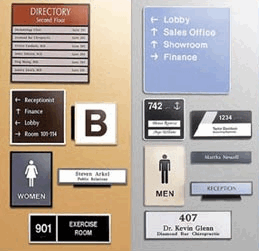The Effect of ADA Signs on Community Ease Of Access
The Effect of ADA Signs on Community Ease Of Access
Blog Article
Discovering the Trick Attributes of ADA Indicators for Boosted Access
In the world of access, ADA indicators work as quiet yet powerful allies, guaranteeing that areas are inclusive and accessible for people with handicaps. By incorporating Braille and tactile elements, these signs damage obstacles for the visually impaired, while high-contrast color pattern and clear fonts deal with varied visual needs. Their critical positioning is not arbitrary yet instead a computed initiative to help with smooth navigating. Yet, beyond these features exists a much deeper narrative about the advancement of inclusivity and the recurring commitment to producing equitable rooms. What much more could these indicators represent in our search of universal accessibility?
Value of ADA Conformity
Ensuring compliance with the Americans with Disabilities Act (ADA) is crucial for promoting inclusivity and equivalent gain access to in public rooms and workplaces. The ADA, passed in 1990, mandates that all public centers, employers, and transportation services suit individuals with specials needs, guaranteeing they enjoy the exact same civil liberties and opportunities as others. Compliance with ADA requirements not just meets legal commitments but also improves a company's credibility by showing its dedication to variety and inclusivity.
Among the key aspects of ADA compliance is the application of available signage. ADA indications are made to ensure that people with impairments can easily navigate via buildings and spaces. These indications have to stick to certain standards relating to size, font style, shade comparison, and positioning to assure presence and readability for all. Correctly carried out ADA signs helps eliminate obstacles that people with impairments commonly run into, consequently advertising their freedom and self-confidence (ADA Signs).
Furthermore, sticking to ADA policies can alleviate the risk of possible fines and lawful effects. Organizations that stop working to adhere to ADA guidelines might deal with fines or legal actions, which can be both damaging and financially challenging to their public picture. Thus, ADA conformity is integral to cultivating an equitable setting for everybody.
Braille and Tactile Components
The unification of Braille and tactile aspects into ADA signs symbolizes the principles of availability and inclusivity. It is commonly put beneath the equivalent message on signage to make certain that people can access the info without aesthetic support.
Tactile elements extend past Braille and consist of elevated personalities and symbols. These parts are made to be discernible by touch, permitting people to determine room numbers, bathrooms, leaves, and various other critical locations. The ADA sets particular guidelines pertaining to the size, spacing, and positioning of these responsive aspects to maximize readability and ensure consistency throughout various environments.

High-Contrast Shade Plans
High-contrast color pattern play a pivotal duty in improving the visibility and readability of ADA signs for individuals with aesthetic disabilities. These schemes are essential as they take full advantage of the difference in light reflectance between message and background, ensuring that indications are easily noticeable, also from a distance. The Americans with Disabilities Act (ADA) mandates making use of particular shade contrasts to fit those with minimal vision, making it a crucial facet of compliance.
The efficiency of high-contrast colors hinges on their capacity to attract attention in various lights conditions, consisting of dimly lit settings and areas with glare. Typically, dark text on a light history or light message on a dark background is utilized to attain optimum contrast. For circumstances, black text on a yellow or white history offers a stark aesthetic difference that aids in fast acknowledgment and comprehension.

Legible Fonts and Text Dimension
When considering the design of ADA signs, the selection of understandable fonts and suitable text dimension can not be overstated. These elements are important for making sure that indicators are obtainable to individuals with aesthetic disabilities. The Americans with Disabilities Act (ADA) mandates that fonts should be not italic and sans-serif, oblique, manuscript, highly ornamental, or of uncommon kind. These needs help guarantee that the text is easily readable from a distance which the characters are distinguishable to diverse target markets.
According to ADA guidelines, the minimum message height need to be 5/8 inch, and it must increase proportionally with watching range. Uniformity in text size adds to a natural visual experience, aiding people in navigating settings efficiently.
Furthermore, spacing between letters and lines is important to legibility. Ample spacing stops personalities from showing up crowded, improving readability. By visit site sticking to these standards, developers can considerably boost ease of access, ensuring that signage offers its intended function for all people, despite their aesthetic capacities.
Effective Positioning Approaches
Strategic placement of ADA signage is important for making best use of ease of access and guaranteeing compliance with legal requirements. Correctly located indicators direct people with disabilities successfully, promoting navigation in public spaces. Secret considerations consist of elevation, presence, and closeness. ADA guidelines stipulate that indications must be placed at an elevation in between 48 to 60 inches from the ground to guarantee Discover More they are within the line of view for both standing and seated individuals. This standard height range is crucial for inclusivity, allowing wheelchair customers and people of differing elevations to accessibility details easily.
In addition, indications have to be put beside the latch side of doors to permit very easy identification before access. This positioning assists individuals situate areas and spaces without obstruction. In cases where there is no door, indicators must be located on the nearest surrounding wall. Consistency in indicator placement throughout a center boosts predictability, decreasing complication and boosting overall Visit Website user experience.

Final Thought
ADA indicators play an essential duty in promoting ease of access by integrating features that deal with the requirements of individuals with impairments. These elements collectively promote an inclusive atmosphere, underscoring the value of ADA compliance in making sure equal gain access to for all.
In the realm of ease of access, ADA indications serve as silent yet powerful allies, guaranteeing that areas are navigable and comprehensive for individuals with specials needs. The ADA, established in 1990, mandates that all public centers, companies, and transport solutions suit people with specials needs, guaranteeing they take pleasure in the exact same rights and chances as others. ADA Signs. ADA indicators are designed to guarantee that people with disabilities can conveniently browse with areas and structures. ADA standards stipulate that indicators ought to be placed at an elevation between 48 to 60 inches from the ground to guarantee they are within the line of sight for both standing and seated people.ADA signs play an essential function in promoting availability by integrating functions that attend to the needs of people with disabilities
Report this page